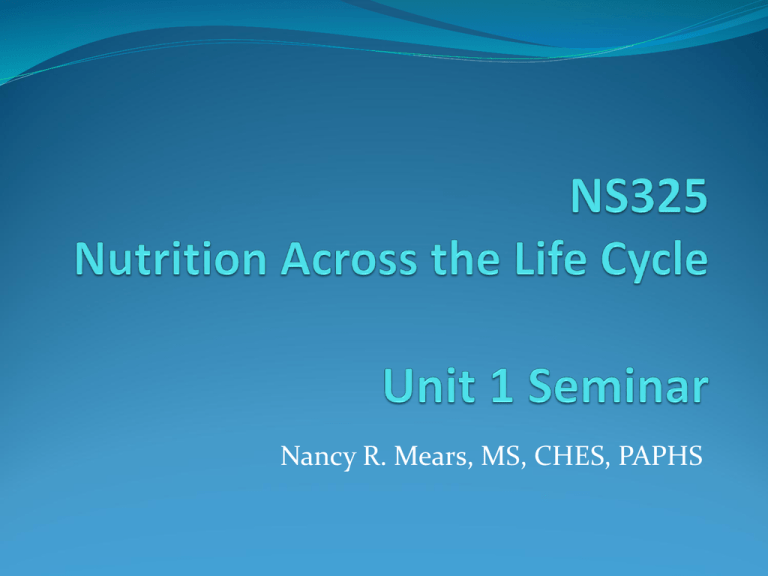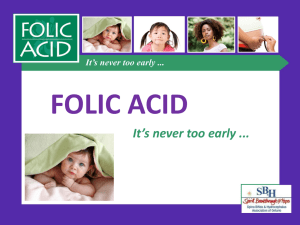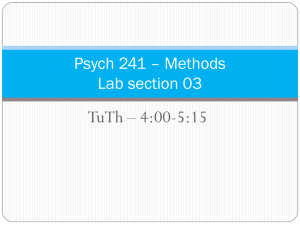Document
advertisement

Nancy R. Mears, MS, CHES, PAPHS Seminar 1 - Outline 1. 2. 3. 4. 5. Get to know each other Go over syllabus Answer your questions Pre-Pregnancy Physical Activity Pre-Pregnancy Nutrition A little about me… I have been married to my wonderful husband for almost 13 years; We have 2 sons ages 9 & 7 years old; We live in Southern Delaware; I work full-time for a public school district as a School Nutrition Manager and am a Certified Health Education Specialist (CHES) and a Physical Activity in Public Health Specialist (PAPHS); I am new to Kaplan University and am excited to be here! Now – your turn! Get your typing fingers ready…. Tell us an interesting fact about yourself! Questions? I will try to put in question slides throughout the seminar power points. I can answer questions at any time. To get my attention – just type a question As soon as I finish my thought, I will answer your question. If you are still unclear – send me an email and I will get to it right after seminar. If there is something that I cannot answer right away, I will get back to you. Moving Forward Let’s look at the syllabus First, the basics: Here is my contact info: • Kaplan Email Address: NMears@kaplan.edu I will get back to you within 24 hours during the week and within 48 hours on the weekends. AOL AIM: ProfessorMears Course Description Studies in this course encompass the nutritional issue across the life cycle, including pregnancy, childbirth and lactation. The course considers nutritional aspects related to neonates, infants and children. The special needs of adolescents and disorders affecting this age group are discussed. The coursework will also include discussion of nutritional demands and food choices in geriatric population. Why do I need to know this? Having read the course description, how will this course be important to your career? Grading Criteria/Course Evaluation Grade Distribution and Weighting Total Points 9 Discussion Questions (50 points each) 450 6 Case Studies (50 points each) 300 Aging Project 50 Final Project 200 TOTAL: 1,000 points When will I get my grades? Discussion and assignment/case study grades will be updated each week no later than Sunday of the week following the unit’s completion Approved Late work will be graded within five days of the submission date Course Policies: How to Label Your Work Assignments: Please label your projects: username- assignmentunit#.doc. For example, a student named Nancy Mears would name her file NMears-Unit 3Assignment.doc. Email Subject Lines: Please start your subject lines in email correspondence with course & section username: SUBJECT_OF_MESSAGE. For example, NS325-02NMears: Question regarding project. My dog ate my homework… Course Policies: Late Work Policy Late work will not be accepted unless there are clear and compelling extenuating circumstances. If you have extenuating circumstances that prevent you from completing course assignments/exams you must contact your instructor immediately—prior to the assignment/exam/quiz due-date unless prevented from doing so by emergency circumstances. Examples of extenuating circumstances are serious personal and/or family illness/hospitalization, death in the family, weather-related evacuation/emergencies, work emergencies, and issues related to active military assignment. Personal computer/software/internet connectivity issues and course blocks are not considered extenuating circumstances. Granting of late-work submission due to extenuating circumstances is at the discretion of the instructor and will require documentation for verification of extenuating circumstances. If late work submission is granted, the instructor will establish new due-dates and requirements without loss of course points. Seminars A description of all seminars to be held can be found under each of the units in the course. Seminars will NOT be graded in this course – they are OPTIONAL Discussion Boards Each week you will be required to participate in the discussion board. Unit 1 is the only time you will find two separate discussions (the Introduction Discussion is not graded) The other units there will only be 1 discussion. How do I get an “A” in the Discussion boards? Students are expected to post: A minimum of three posts per unit discussion thread: One post in response to the instructor’s question by the end of day Saturday. Two posts in response to two classmates by the end of the unit which is Tuesday. Responses need to be on topic, original and contribute to the quality and advancement of the discussion. References are utilized where appropriate and are cited using APA format. Responses meet posted length requirements. Responses are clearly written and contain few spelling/grammatical errors. Referencing in the Discussions When you are posting to the discussion boards, please remember to reference your material! If it is not a thought that comes straight from your head, you must reference the source of your material. Points will be deducted if material is not referenced We must give credit where credit is due Plagiarism – Don’t do it! • Plagiarism - Using another person’s words, ideas, or results without giving proper credit to that person; giving the impression that it is the student’s own work • Please read the syllabus regarding the specifics of plagiarism. • Kaplan University subscribes to a third-party plagiarism detection service, and reserves the right to check all student work to verify that it meets the guidelines of this policy. • Penalties for Plagiarism: • 1st offense: Failure of the assignment in which the action occurred. • 2nd offense: Failure of the class in which the action occurred. • 3rd offense: Expulsion or permanent dismissal from the University. APA Format Required Be sure to have your project assignments submitted in this correct format Title Page Double spaced Reference page in APA format You can potentially drop your grade from an “A” to a “B” by not following this format. Use the tools, on line help, and tutors available to you (Writing Center) You must use in text citation to list a reference at the end of you paper. APA Review – What is APA? APA = American Psychological Association National standard for the layout of an academic paper and gives a universal method for referencing sources used in these types of papers. Please remember, we need to use APA in our discussions, seminar option 2, and assignments. APA - Citations We cite another author’s data to avoid plagiarism, to give him or her credit for their work, and to make it easy for your reader to do follow-up research. You must, absolutely must, give credit to the original author. Failure to do so results in plagiarism. Would you want someone else taking credit for your hard work? Research scientists, government officials, and other experts don’t like it either. APA – Citations Examples Paraphrasing Adolescent boys and girls experience rapid growth but at significant differences in rate (Edelstein & Sharlin, 2009). Direct Quote “The adolescent growth spurt takes 2 to 4 years to complete and is generally longer in boys thank in girls”(Edelstein & Sharlin, 2009, p. 109). How To Reference Our Text in APA Format Edelstein, S. & Sharlin, J. (2009). Life Cycle Nutrition: An Evidence Based Approach. Massachusetts: Jones and Bartlett Publishers. Tutoring and Help KU Writing Center Tutoring APA citation Review grammar See sample essays Chat with a live tutor Submit a paper and receive feedback in 48 – 72 hours. Pre-Pregnancy Nutrition & Physical Activity Pre-pregnancy Physical Activity Benefits of Physical Activity Physical activity is any form of exercise or movement of the body that uses energy. Having an active lifestyle can help all women be healthy. Regular physical activity can lower your risk of: Heart disease Stroke High blood pressure Breast or colon cancer Type 2 diabetes (often related to being overweight) Osteoarthritis (most common form of arthritis) Osteoporosis (weakens bones and affects many women) Benefits of Physical Activity (cont…) Improve a person’s mood Reduce feelings of mild or moderate depression Help with managing stress Help with managing weight Help with sleeping better Increase energy throughout the day www.marchofdimes.com Pre-Pregnancy Nutrition: Folic Acid Folic Acid Folic acid, a B vitamin, helps prevent birth defects of the brain and spinal cord when taken before the end of early pregnancy. It is available in most multivitamins, as a folic acid-only supplement and in some foods. www.marchofdimes.com Folic Acid When should you begin taking folic acid? A. When you're three months pregnant B. When your health care provider prescribes prenatal vitamins C. Before you start trying to get pregnant D. Every time you have sex Answer You should begin taking folic acid before you start trying to get pregnant. Folic Acid You're trying to get more folic acid in your diet. Which of the following foods is your best choice? A. B. C. D. Baked potato Cheeseburger Fortified breakfast cereal Pizza Answer Fortified breakfast cereal is your best choice to get more folic acid in your diet. Folic Acid You're thirsty and you have a choice of the following beverages. Which is the best choice if you're trying to increase your intake of folic acid? A. Cranberry juice B. Orange juice C. Apple juice D. Lemonade Answer Orange juice is the best choice of beverage if you're trying to increase your intake of folic acid. Folic Acid The best way to get enough folic acid to help protect your baby from birth defects of the brain and spinal cord is: A. B. C. D. Eat a banana every day Take a multivitamin with 400 micrograms of folic acid every day Drink two glasses of milk every day Do nothing; most women get enough in their diets Answer Take a multivitamin with 400 micrograms of folic acid every day. Folic Acid Take a multivitamin with 400 micrograms of folic acid every day before pregnancy and during early pregnancy, as part of a healthy diet. Eat a healthy diet that includes foods that contain folate, the natural form of the vitamin. Folic Acid Foods Fortified breakfast cereals (look on the label to see if the cereal has been fortified with folic acid) Lentils Asparagus Spinach Black beans Peanuts (only if you do not have a peanut allergy) Orange juice (from concentrate is best) Enriched breads and pasta Romaine lettuce Broccoli Pre-Pregnancy Nutrition: Smoking & Alcohol Smoking and Pregnancy 10% of pregnant women smoke Cigarette smoke contains over 2,500 chemicals If pregnant women stopped smoking there would be 11% reduction still births and 5% reduction in new born deaths Smoking and Newborn Risk Doubles risk of low birth weight Increases risk of preterm delivery Increases risk of lifelong problems such as cerebral palsy, mental retardation and death Possibility of withdrawal symptoms Smoking and Pregnancy Problems Placenta previa (a low-lying placenta that covers part or all of the opening of the uterus) Placental abruption (in which the placenta peels away, partially or almost completely, from the uterine wall before delivery) Both can result in heavy bleeding during delivery that can endanger mother and baby, although cesarean delivery can prevent most deaths. Second-Hand smoke? Some studies have shown poor fetal growth and the babies are more likely to have a low birth weight. Alcohol and Pregnancy FASD (fetal alcohol spectrum disorders) Some recent surveys show that 1 in 12 women drink alcohol during pregnancy One in 30 report binge drinking during pregnancy Alcohol and the Fetus Alcohol metabolized more slowly in fetus due to immature systems Alcohol passes through placenta Effects can range from mild to severe Some Effects of Alcohol Mild to severe mental retardation Learning, emotional and behavioral problems Defects in organs, heart, and/or face Fetal alcohol syndrome FAS (Fetal Alcohol Syndrome) Between 1000 and 6000 babies born with this condition in US Symptoms include low birth weight, poor growth, malformed organs, small eyes, mental disability, poor coordination, poor attention, emotional and behavioral problems Illicit Drugs and Pregnancy According to a 2005 govt survey about 4% of pregnant women use illicit drugs during pregnancy. Often these drugs cause poor fetal growth, early delivery, birth defects, learning and behavioral problems. These women often have poor nutritional status Methamphetamine AKA: speed, ice crank, crystal meth 3X likely to have low birth weight Increased risk of heart defects and cleft palate/lip Increase risk of problems with placenta and early birth References Edelstein, S. & Sharlin, J. (2009). Life Cycle Nutrition: An Evidence Based Approach. Massachusetts: Jones and Bartlett Publishers. March of Dimes. (2010). Retrieved from http://www.marchofdimes.com






